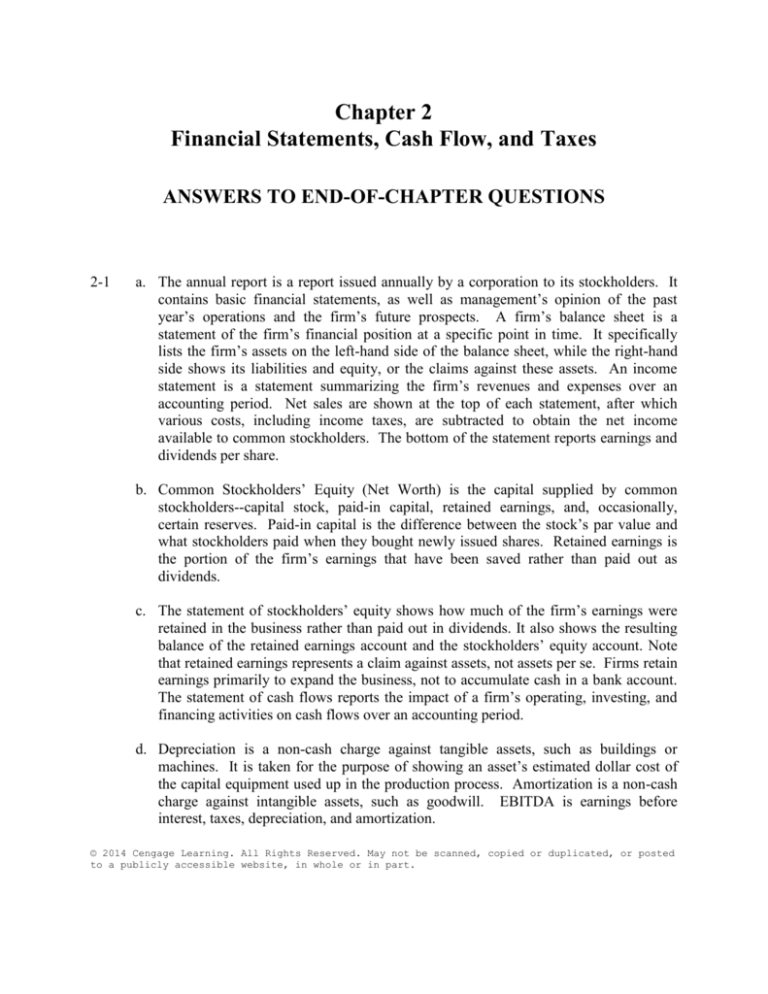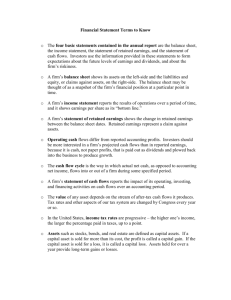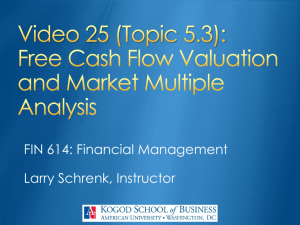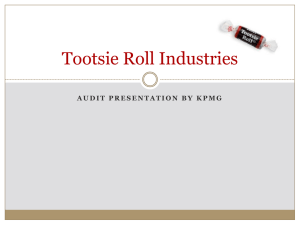
Chapter 2
Financial Statements, Cash Flow, and Taxes
ANSWERS TO END-OF-CHAPTER QUESTIONS
2-1
a. The annual report is a report issued annually by a corporation to its stockholders. It
contains basic financial statements, as well as management’s opinion of the past
year’s operations and the firm’s future prospects. A firm’s balance sheet is a
statement of the firm’s financial position at a specific point in time. It specifically
lists the firm’s assets on the left-hand side of the balance sheet, while the right-hand
side shows its liabilities and equity, or the claims against these assets. An income
statement is a statement summarizing the firm’s revenues and expenses over an
accounting period. Net sales are shown at the top of each statement, after which
various costs, including income taxes, are subtracted to obtain the net income
available to common stockholders. The bottom of the statement reports earnings and
dividends per share.
b. Common Stockholders’ Equity (Net Worth) is the capital supplied by common
stockholders--capital stock, paid-in capital, retained earnings, and, occasionally,
certain reserves. Paid-in capital is the difference between the stock’s par value and
what stockholders paid when they bought newly issued shares. Retained earnings is
the portion of the firm’s earnings that have been saved rather than paid out as
dividends.
c. The statement of stockholders’ equity shows how much of the firm’s earnings were
retained in the business rather than paid out in dividends. It also shows the resulting
balance of the retained earnings account and the stockholders’ equity account. Note
that retained earnings represents a claim against assets, not assets per se. Firms retain
earnings primarily to expand the business, not to accumulate cash in a bank account.
The statement of cash flows reports the impact of a firm’s operating, investing, and
financing activities on cash flows over an accounting period.
d. Depreciation is a non-cash charge against tangible assets, such as buildings or
machines. It is taken for the purpose of showing an asset’s estimated dollar cost of
the capital equipment used up in the production process. Amortization is a non-cash
charge against intangible assets, such as goodwill. EBITDA is earnings before
interest, taxes, depreciation, and amortization.
© 2014 Cengage Learning. All Rights Reserved. May not be scanned, copied or duplicated, or posted
to a publicly accessible website, in whole or in part.
e. Operating current assets are the current assets used to support operations, such as
cash, accounts receivable, and inventory. It does not include short-term investments.
Operating current liabilities are the current liabilities that are a natural consequence of
the firm’s operations, such as accounts payable and accruals. It does not include
notes payable or any other short-term debt that charges interest. Net operating
working capital is operating current assets minus operating current liabilities. Total
net operating capital is sum of net operating working capital and operating long-term
assets, such as net plant and equipment. Operating capital also is equal to the net
amount of capital raised from investors. This is the amount of interest-bearing debt
plus preferred stock plus common equity minus short-term investments.
f. Accounting profit is a firm’s net income as reported on its income statement. Net
cash flow, as opposed to accounting net income, is the sum of net income plus noncash adjustments. NOPAT, net operating profit after taxes, is the amount of profit a
company would generate if it had no debt and no financial assets. Free cash flow is
the cash flow actually available for distribution to investors after the company has
made all investments in fixed assets and working capital necessary to sustain ongoing
operations.
g. Market value added is the difference between the market value of the firm (i.e., the
sum of the market value of common equity, the market value of debt, and the market
value of preferred stock) and the book value of the firm’s common equity, debt, and
preferred stock. If the book values of debt and preferred stock are equal to their
market values, then MVA is also equal to the difference between the market value of
equity and the amount of equity capital that investors supplied. Economic value
added represents the residual income that remains after the cost of all capital,
including equity capital, has been deducted.
h. A progressive tax means the higher one’s income, the larger the percentage paid in
taxes. Taxable income is defined as gross income less a set of exemptions and
deductions which are spelled out in the instructions to the tax forms individuals must
file. Marginal tax rate is defined as the tax rate on the last unit of income. Average
tax rate is calculated by taking the total amount of tax paid divided by taxable
income.
i. Capital gain (loss) is the profit (loss) from the sale of a capital asset for more (less)
than its purchase price. Ordinary corporate operating losses can be carried backward
for 2 years or forward for 20 years to offset taxable income in a given year.
© 2014 Cengage Learning. All Rights Reserved. May not be scanned, copied or duplicated, or posted
to a publicly accessible website, in whole or in part.
j. Improper accumulation is the retention of earnings by a business for the purpose of
enabling stockholders to avoid personal income taxes on dividends. An S corporation
is a small corporation which, under Subchapter S of the Internal Revenue Code, elects
to be taxed as a proprietorship or a partnership yet retains limited liability and other
benefits of the corporate form of organization.
2-2
The four financial statements contained in most annual reports are the balance sheet,
income statement, statement of stockholders’ equity, and statement of cash flows.
2-3
No, because the $20 million of retained earnings doesn’t mean the company has $20
million in cash. The retained earnings figure represents cumulative amount of net income
that the firm has not paid out as dividends during its entire history. Thus, most of the
reinvested earnings were probably spent on the firm’s operating assets, such as buildings
and equipment.
2-5
Operating capital is the amount of interest bearing debt, preferred stock, and common
equity used to acquire the company’s net operating assets. Without this capital a firm
cannot exist, as there is no source of funds with which to finance operations.
2-6
NOPAT is the amount of net income a company would generate if it had no debt and held
no financial assets. NOPAT is a better measure of the performance of a company’s
operations because debt lowers income. In order to get a true reflection of a company’s
operating performance, one would want to take out debt to get a clearer picture of the
situation.
2-7
Free cash flow is the cash flow actually available for distribution to investors after the
company has made all the investments in fixed assets and working capital necessary to
sustain ongoing operations. It is the most important measure of cash flows because it
shows the exact amount available to all investors.
2-8
If the business were organized as a partnership or a proprietorship, its income could be
taken out by the owners without being subject to double taxation. Also, if you expected
to have losses for a few years while the company was getting started, if you were not
incorporated, and if you had outside income, the business losses could be used to offset
your other income and reduce your total tax bill. These factors would lead you to not
incorporate the business. An alternative would be to organize as an S Corporation, if
requirements are met.
© 2014 Cengage Learning. All Rights Reserved. May not be scanned, copied or duplicated, or posted
to a publicly accessible website, in whole or in part.
SOLUTIONS TO END-OF-CHAPTER PROBLEMS
2-1
Corporate yield = 9%; T = 35.5%
AT yield = 9%(1 - T)
= 9%(0.645) = 5.76%.
2-2
Corporate bond yields 8%. Municipal bond yields 6%.
Equivalent pretax yield Yield on muni
on taxable bond
(1 T)
6%
8%
(1 T)
0.08 0.08 T 0.06
0.08 T 0.02
T 25 %.
2-3
NI = $3,000,000; EBIT = $6,000,000; T = 40%; Interest = ?
Need to set up an income statement and work from the bottom up.
EBIT
Interest
EBT
Taxes (40%)
NI
$6,000,000
1,000,000
$5,000,000
2,000,000
$3,000,000
$3,000,000
EBT = (1 T)
$3,000,000
0.6
Interest = EBIT – EBT = $6,000,000 – $5,000,000 = $1,000,000.
2-4
EBITDA = $7,500,000; NI = $1,800,000; Int = $2,000,000; T = 40%; DA = ?
EBITDA
DA
EBIT
Int
EBT
Taxes (40%)
NI
$7,500,000
2,500,000
$5,000,000
2,000,000
$3,000,000
1,200,000
$1,800,000
EBITDA – DA = EBIT; DA = EBITDA – EBIT
EBIT = EBT + Int = $3,000,000 + $2,000,000
(Given)
$1,800 ,000 $1,800 ,000
(1 T)
0.6
(Given)
© 2014 Cengage Learning. All Rights Reserved. May not be scanned, copied or duplicated, or posted
to a publicly accessible website, in whole or in part.
2-5
NI = $3,100,000; DEP = $500,000; AMORT = 0; NCF = ?
NCF = NI + DEP and AMORT = $3,100,000 + $500,000 = $3,600,000.
2-6
NI = $50,000,000; R/EY/E = $810,000,000; R/EB/Y = $780,000,000; Dividends = ?
R/EB/Y + NI – Div = R/EY/E
$780,000,000 + $50,000,000 – Div = $810,000,000
$830,000,000 – Div = $810,000,000
$20,000,000 = Div.
2-7
Income
Less Interest deduction
Plus: Dividends receiveda
Taxable income
$365,000
(50,000)
4,500
$319,500
a
For a corporation, 70% of dividends received are excluded from taxes; therefore, taxable
dividends are calculated as $15,000(1 - 0.70) = $4,500.
Tax = $22,250 + ($319,500 - $100,000)(0.39) = $22,250 + $85,605 = $107,855.
After-tax income:
Taxable income
Taxes
Plus Non-taxable dividends receivedb
Net income
b
$319,500
(107,855)
10,500
$222,145
Non-taxable dividends are calculated as $15,000 x 0.7 = $10,500.
The company’s marginal tax rate is 39 percent. The company’s average tax rate is
$107,855/$319,500 = 33.76%.
2-8
a. Tax = $3,400,000 + ($10,500,000 - $10,000,000)(0.35) = $3,575,000.
b. Tax = $1,000,000(0.35) = $350,000.
c. Tax = ($1,000,000)0.30(0.35) = $105,000.
© 2014 Cengage Learning. All Rights Reserved. May not be scanned, copied or duplicated, or posted
to a publicly accessible website, in whole or in part.
2-9
A-T yield on FLA bond = 5%.
A-T yield on AT&T bond = 7.5% - Taxes = 7.5% - 7.5%(0.35) = 4.875%.
Check: Invest $10,000 @ 7.5% = $750 interest.
Pay 35% tax, so A-T income = $750(1 - T) = $750(0.65) = $487.50.
A-T rate of return = $487.50/$10,000 = 4.875%.
A-T yield on AT&T preferred stock:
A-T yield = 6% - Taxes = 6% - 0.3(6%)(0.35) = 6% - 0.63% = 5.37%.
Therefore, invest in AT&T preferred stock. We could make this a harder problem by
asking for the tax rate that would cause the company to prefer the Florida bond or the
AT&T bond.
2-10
EBIT = $750,000; DEP = $200,000; 100% Equity; T = 40%
NI = ?; NCF = ?; OCF = ?
First, determine net income by setting up an income statement:
EBIT
Interest
EBT
Taxes (40%)
NI
$750,000
0
$750,000
300,000
$450,000
NCF = NI + DEP = $450,000 + $200,000 = $650,000.
© 2014 Cengage Learning. All Rights Reserved. May not be scanned, copied or duplicated, or posted
to a publicly accessible website, in whole or in part.
2-11
a.
Sales revenues
Costs except
depreciation
Depreciation
EBT
Taxes (40%)
Net income
Add back depreciation
Net cash flow
Income Statement
$12,000,000
9,000,000
1,500,000
$ 1,500,000
600,000
$ 900,000
1,500,000
$ 2,400,000
b. If depreciation doubled, taxable income would fall to zero and taxes would be zero.
Thus, net income would decrease to zero, but net cash flow would rise to $3,000,000.
Menendez would save $600,000 in taxes, thus increasing its cash flow:
∆CF = T(∆Depreciation) = 0.4($1,500,000) = $600,000.
c. If depreciation were halved, taxable income would rise to $2,250,000 and taxes to
$900,000. Therefore, net income would rise to $1,350,000, but net cash flow would
fall to $2,100,000.
d. You should prefer to have higher depreciation charges and higher cash flows. Net
cash flows are the funds that are available to the owners to withdraw from the firm
and, therefore, cash flows should be more important to them than net income.
2-12
a.
EBIT
x (1-Tax rate)
Net operating profit after taxes (NOPAT)
$1,260
60.0%
$756
© 2014 Cengage Learning. All Rights Reserved. May not be scanned, copied or duplicated, or posted
to a publicly accessible website, in whole or in part.
b.
Cash
+ Accounts receivable
+ Inventories
Operating current assets
2010
$550
2,750
1,650
$4,950
2009
$500
2,500
1,500
$4,500
Accounts payable
+ Accruals
Operating current liabilities
$1,100
550
$1,650
$1,000
500
$1,500
Operating current assets
- Operating current liabilities
Net operating working capital (NOWC)
$4,950
1,650
$3,300
$4,500
1,500
$3,000
c.
Net operating working capital (NOWC)
+ Net plant and equipment
Total net operating capital
2010
$3,300
3,850
$7,150
NOPAT
- Investment in total net operating capital
Free cash flow
2010
$756
650
$106
2009
$3,000
3,500
$6,500
d.
e.
NOPAT
÷ Total net operating capital
Return on invested capital (ROIC)
2010
$756
7,150
10.57%
© 2014 Cengage Learning. All Rights Reserved. May not be scanned, copied or duplicated, or posted
to a publicly accessible website, in whole or in part.
f.
Uses of FCF
After-tax interest payment =
Reduction (increase) in debt =
Payment of dividends =
Repurchase (Issue) stock =
Purchase (Sale) of short-term investments =
Total uses of FCF =
2010
$72
-$284
$220
$88
$10
$106
© 2014 Cengage Learning. All Rights Reserved. May not be scanned, copied or duplicated, or posted
to a publicly accessible website, in whole or in part.
2-13
Prior Years
Profit earned
Carry-back credit
Adjusted profit
Tax previously
paid (40%)
Tax refund: Taxes
previously paid
2008
2009
$150,000 $150,000
150,000 150,000
$
0
$
0
60,000
60,000
$ 60,000 $ 60,000
Total check from U.S. Treasury = $60,000 + $60,000 = $120,000.
Future Years
Estimated
profit
Carry-forward
credit
Adjusted
profit
Tax (at 40%)
2011
2012
2013
2014
2015
$150,000 $150,000 $150,000 $150,000 $150,000
150,000
$
0
0
150,000
$
$
0
0
50,000
0
0
$100,000 $150,000 $150,000
$ 40,000 $ 60,000 $ 60,000
© 2014 Cengage Learning. All Rights Reserved. May not be scanned, copied or duplicated, or posted
to a publicly accessible website, in whole or in part.









